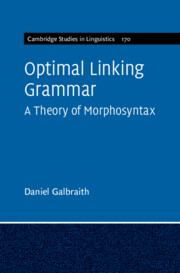3 - Overview of OLG
Published online by Cambridge University Press: 20 April 2023
Summary
Chapter 3 outlines OLG’s core components, giving the prerequisite theoretical background for understanding the data analyses that follow. The Linking Theory section answers questions regarding levels of lexical–semantic and syntactic representation, mapping between levels, and the architecture of grammar. A short review is presented of the core propositions of Optimality Theory (OT) approaches to syntax, including a list of proposed constraints governing case-assignment. Linking Theory originates in Kiparsky (1997); the central innovation is that three levels of case – abstract, morphosyntactic and morphological – are distinguished, and the same set of binary features is seen to operate at all levels, though with level-appropriate realisation. The introduction to OT focuses on its application to the syntactic module of grammar; a key point is that a huge number of unlikely candidates are harmonically bounded by undominated or high-ranked constraints. Such markedness constraints interact with faithfulness constraints enforcing realisation of all features present in the input, preventing omission of input material other than in highly marked forms. This allows us to capture long-standing generalisations about phrase structure without having to claim they will be completely unviolated across languages: language-specific rankings may result in more or less marked structures.
Keywords
Information
- Type
- Chapter
- Information
- Optimal Linking GrammarA Theory of Morphosyntax, pp. 62 - 75Publisher: Cambridge University PressPrint publication year: 2023
